Last Thursday, Ajax and I headed for Exit 47, one of my favorite hiking locations during the pandemic. We’d last hiked to Granite Mountain in August of 2021. The muggy, buggy, smoky hike had me questioning whether I’d made the right choice. There was no question this time. A momentary lull between forest fires meant crisp, clear air, fog, and low clouds. My daughter had successfully completed her first day of college classes. I had some downtime between clients. My husband had a full day of work. So, I seized some quiet time to reflect, move, and hopefully see a few views. What resulted was a beautiful walking meditation among the lovely fall foliage.

What is Walking Meditation?
My own form of “walking meditation” is different from popular literature. My definition incorporates the following elements from forays into forest bathing.
- Feel the sensations of each part of your foot from heel to toe. Notice any hot spots or pebbles.
- Walk with deliberate intention. Swing your arms freely. If you use a trekking pole, trade hands to stay in balance.
- Let yourself notice the beauty surrounding you.
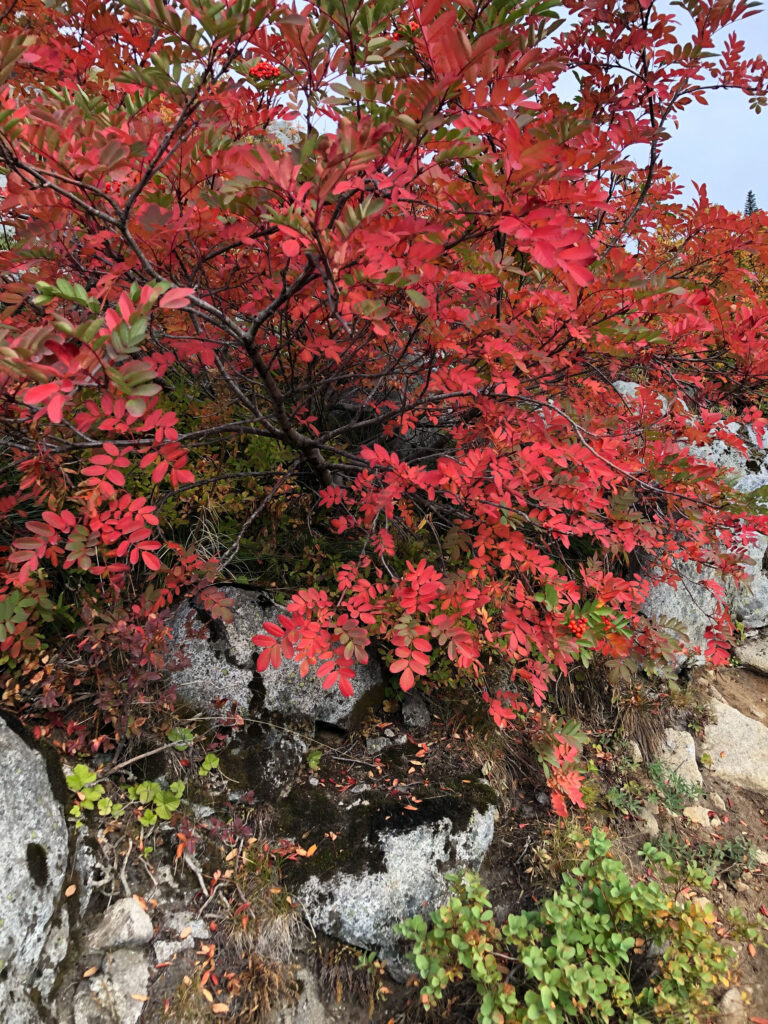
- Focus your attention on the breath, on a point in front of you, on sounds – pick one. It’s okay to shift, just notice when you do. Think of focus as a brain muscle that needs developing, like the heart needs cardiovascular training while the bones, tendons, joints, and ligaments need strength training.
- Feel sensations of the breeze on your face, the cobwebs across the trail, the leaves under your feet, the sweat on your arms.
- Notice when thoughts take over. Gently remind yourself that they are an interpretation in the present moment.
- Release all “shoulds.”
Hiking Without Metrics
Whenever I hike with a human partner, I find I focus more on our conversation than on our surroundings. And as a trainer, I have been known to ask clients to track various aspects of their hikes including ascent time, moving time, elevation gain, and distance. This year, however, I hiked without a pedometer, Whoop strap, Oura ring, or GPS, to the surprise of some of my hiking partners. I always have my cell phone with me for emergencies, so I’m aware of the passage of time. But my focus is on staying comfortable. Moving how my body wants to (including dunking my feet). Enjoying whatever Mother Nature reveals. Being fully present at the moment, as much as possible.
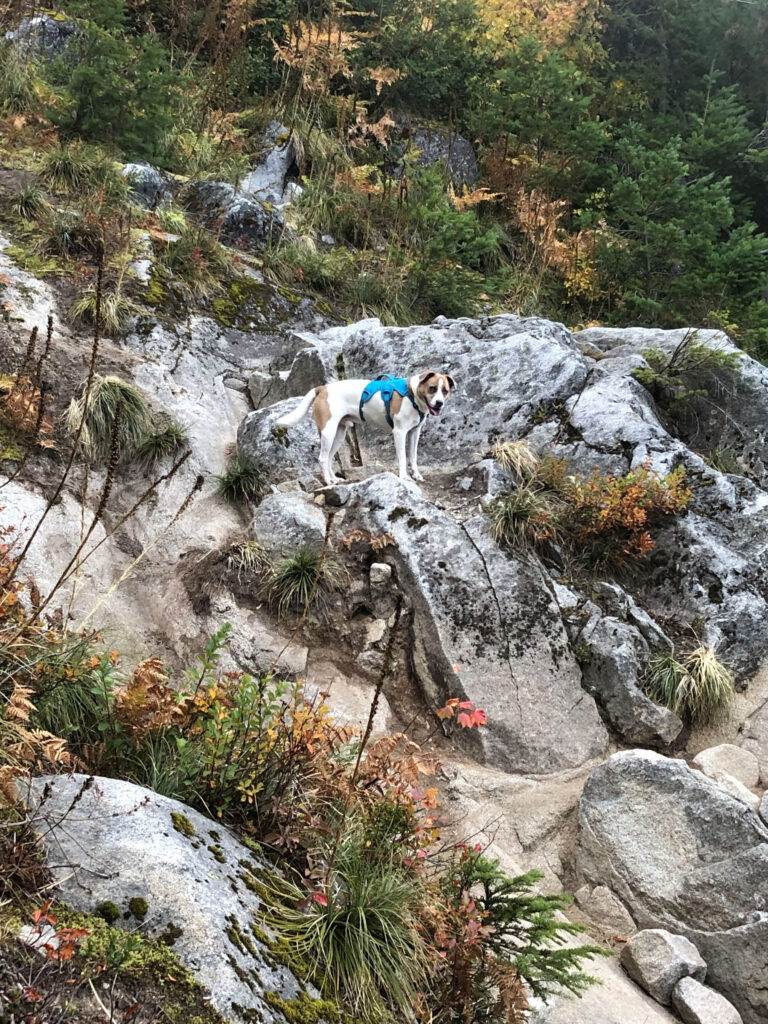
Thoughts During the Ascent
For this walking meditation, we left the trailhead at 6:45 with only one person on the trail ahead of us. For the next few hours, we had the mountain all to ourselves. I had plenty of time to think. But some of my thoughts were rather unexpected. And they bumped all over the place, revealing my present state of mind.
- What would it be like to be completely alone, with no human interaction, for months?
- What would I do if something happened to my husband, my daughter, or my dog?
- Would we hear another bear like we did last year?
- How will my daughter handle her current roommate situation at the University of Washington?
- How do I really feel about this new stage in my life?
- Why am I here?
- What should I do next with my life?
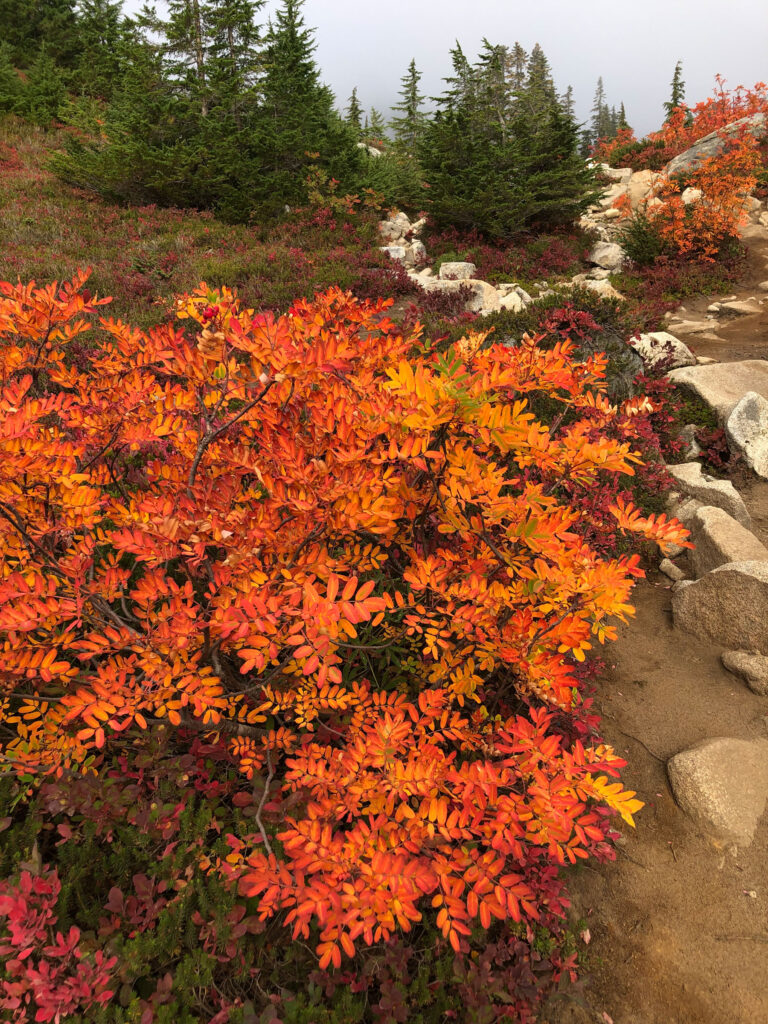
Everyone who is loving and human has (or will have) variations of these thoughts at some point in their lives. But walking meditation enables you to recognize them as thoughts and let them float by. I was not out there to solve anything, necessarily. I was out there to let myself be, thoughts and all. And hopefully come back grounded.
Alone: What Is Your Reaction to Solitude?
I also spent more time than I expected thinking about the survival reality series, Alone. My husband and I stumbled across season eight on Netflix several weeks ago, and it captivated us so strongly that we started watching previous seasons on the History channel.
What compels a person to leave their homes and families for an unknown period of time? at an unspecified location? with ten pieces of survival gear and no water or food? What do they discover about themselves in the wilderness, and what makes them tap out (quit the contest)? Some of the show’s participants last less than 24 hours. Would we run into bears on the mountain like the participants? What would I do if one of us got injured?
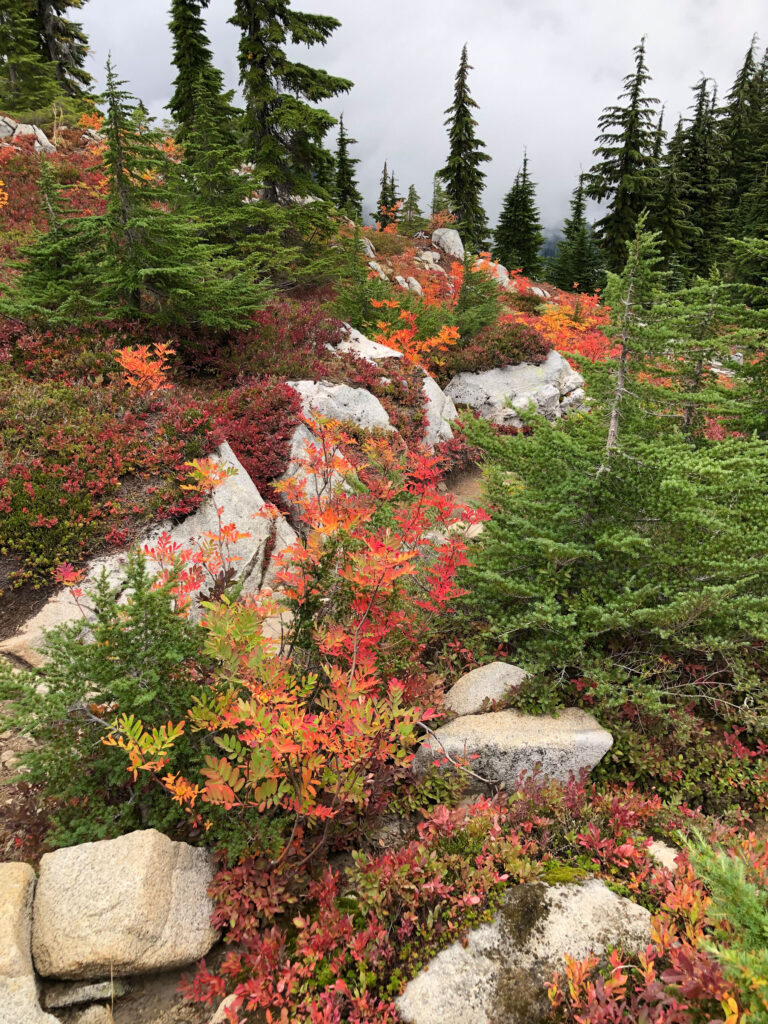
How long would I last off-grid, in an area where there are cougars, bears, and wolves, without human contact? The answer? Probably about three days, which was how long I lasted last December before I insisted on getting home to my daughter, my husband, and my dog. Certainly not the months that winners endure. On this hike to Granite Mountain, I didn’t find answers to my musings. I found something better.
Walking Meditation: Nature Replaces Thoughts
Once we hiked past the forest switchbacks and started up the avalanche gully where the maples, blueberry and huckleberry bushes, and mountain ashes were turning color, the chatter in my mind finally stilled. Mother Nature captivated me with her beautiful artwork. The foliage was even more splendid than the previous week’s hike to Gem and Snow Lakes. Jaw-dropping colors at every turn demanded to be photographed. I obliged.
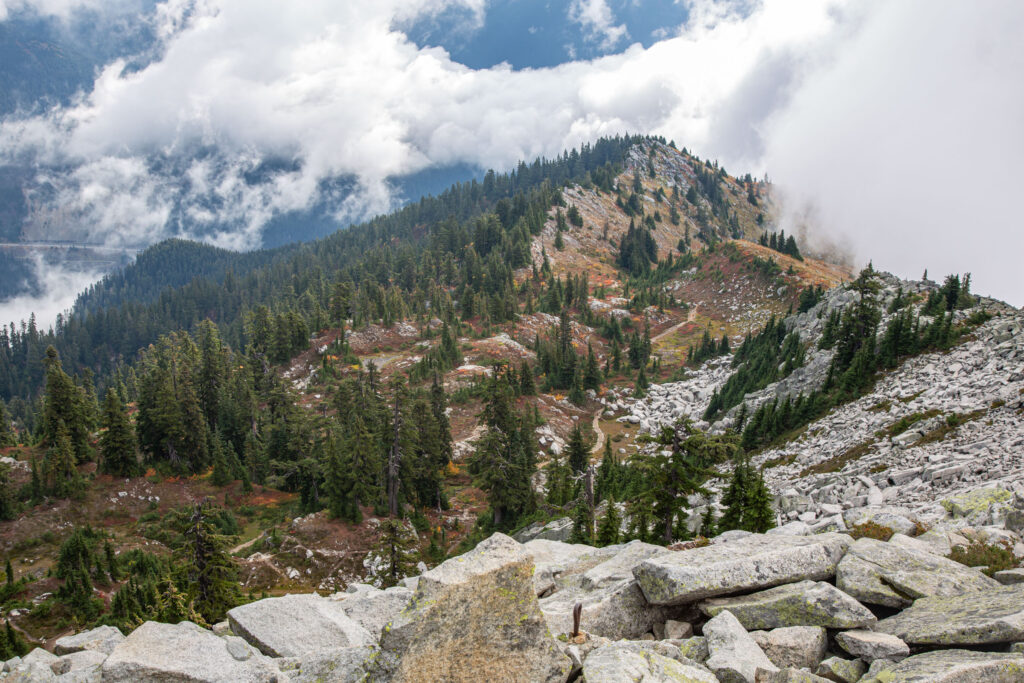
When we reached the summit at 9:30, we enjoyed it for over half an hour, all to ourselves. I jotted down thoughts and ideas I’d had during our hike in my journal. I recalled the nasty mosquitoes I’d had to fight off the previous August and starred in the margin, “Shoulder season on Granite Mountain – NO BUGS, no people, A-MA-ZING colors.”
Musings on the Descent
On the way down, my thoughts traveled along a much different path. No need to worry about bears with hikers giggling and chattering loudly on the way up. But instead of getting annoyed, I felt relieved. I was not a contestant on Alone, after all. There were humans around me. Not many, but enough. I’d had my “me time” and felt ready to rejoin civilization. I didn’t have answers, but I was newly grounded. Nature’s beauty healed something within and gave me courage and fortitude to face whatever obstacles come next. I was right where I needed to be, both on the trail and in my life.
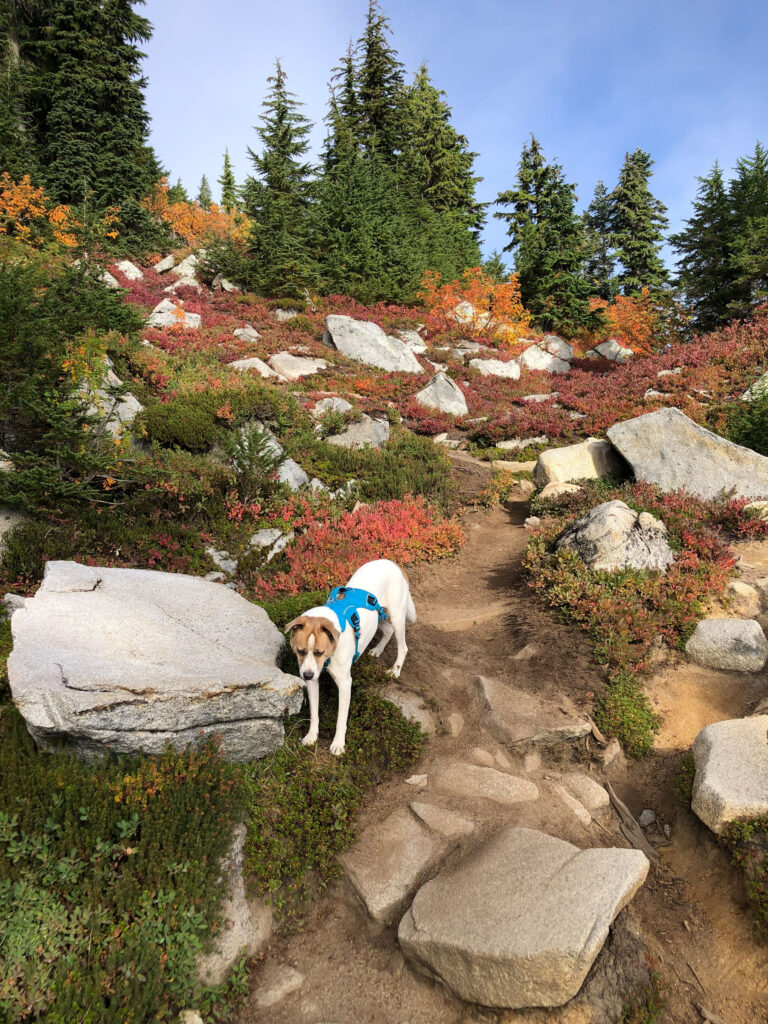
How does hiking change you? Does it challenge, frustrate, or ground you? How? Please share your insights, reactions, or comments below. We love hearing from readers.

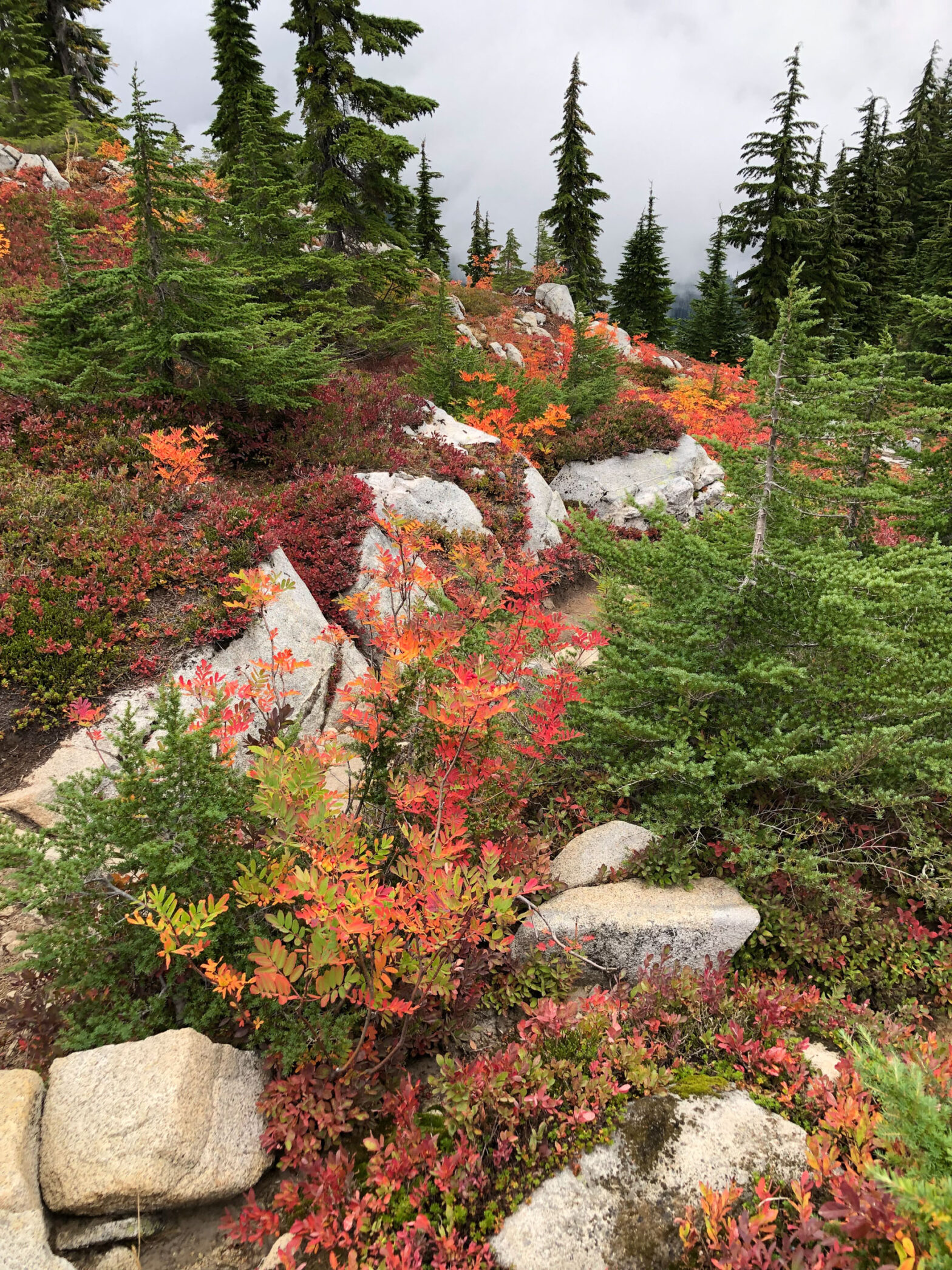
I think your opening summary covers a few essentials about what hiking brings to me: “quiet time to reflect, move, and hopefully see a few views”. Starting on a trail is the closest I ever come to stopping my brain from pinballing around through endless lists of “to remember”, “to do”, “to worry about”, etc. That nearly instantaneous quieting down of the constant “buzzing” comes naturally and is accompanied by a deep relaxing of my breathing and a releasing of the tension throughout my body. I do often refer to these sensations as “coming back home” after a fairly harrowing journey.
Then there is indeed the “moving”; everything about it sustains the calming down process: following a naturally flowing pace and the harmonized breathing rhythms; discovering the trail and its surroundings as the hours go by, a seldom achieved awareness of how all parts of my body work in unison to carry me forward, the simple bliss of being able to be “out there”. Then, of course, there are “the views”, big and small. Spectacular views are a fabulous icing on the cake… but “the cake” is everywhere if I only focus my attention on it. Your pictorial of the Granite Mountain hike is a very good example: fall colors! Wildlife, stately conifers, wildflowers-covered spring meadows, waterfalls, mossy boulders, a breeze pushing ‘waves’ across a grassy field… infinite wealth of beauty around us at nearly every step.
Beyond all this, there is no shortage of data about the many ways hiking works wonders for our health (even more so as we get older it seems). Now…what about partners? I would love to be able to hike and backpack with others but, like you, it seems impossible to find “the right fit”. For good reasons or not (I would need to think more about that…) I have a fairly long list of “must-have” for me to enjoy being outdoors; most of the entries on that list are the result of spending many years “finding my way” through the process of hiking/backpacking… and I don’t think I can give them up without jeopardizing the essence of what being on the trail means for me.
The recognition that there are countless ways to hike is, I believe, at the heart of the HYOH (Hike Your Own Hike) acronym that used to be ubiquitous among the long-distance hiking community. “My Own Hike” can be described in part as follows: be at the trailhead as early as possible (at or even before sunrise); go for new trails as much as possible; aim for “long” distances (both to amplify the “moving” feeling and to get to a point where there will be fewer hikers around); take VERY regular breaks (rest/food) to maintain maximum energy levels; travel light and at my forever pace – the PACE criteria seems to quickly exclude most prospective partners (too fast, too slow, not enough breaks, too many breaks, etc.); if camping, try and “get there” with enough daylight to quietly set up camp and rest; camp away from other hikers; have simple and rapid meal options (I don’t get out to have a 5-course meal at the end of the day); etc.
It is no wonder that, when on long distance journeys, I see almost NO ONE (other than couples) walking together… even if they CAMP together at the end of the day. As I get older though… I am thinking about the big “C” (compromise) as going solo adds to the element of risk. What about SOLITUDE? I love it 95% of the time on the trail. I have never been anywhere close to what the competitors of “Alone” are asked to do, but I got small glimpses here and there. I don’t know whether I could do it and I think I can live with not knowing 😊 Solitude IS one of the great treasures I hunt for on the trail and, like other delights (chocolate anyone?), it seems to agree with me in reasonable doses.
The few times I “binged” on it (relatively… I only spent about 3 days moving without seeing anyone), it started negatively affecting what I value in the outdoors; I started feeling the monotony of the days, the somewhat narcissistic endeavor (what am I trying to prove), the mildly masochistic drive to “feel pain”… the negative feelings slowly overwhelmed the joy of being outdoors. So… now I can add “sharing my experience with other hikers” as another “gain” I look forward to when on the trail.
Gerard,
Thanks for bringing up a new acronym I haven’t seen before — HYOH — Hike Your Own Hike. Funny; I remember making a few up on this blog like KISAGE (Keep It Simple and Good Enough) but I see HYOH is a very real thing for thru-hikers. Link here for anyone interested. https://thetrek.co/thru-hiker-resources/appalachian-trail-glossary/hyoh-hike-your-own-hike/
Another point you bring up is very important for anyone going to the wilderness: What are your expectations for yourself? In Washington State a popular fall hike is at Maple Pass over in Winthrop. When I saw a recent Facebook post showing the hundreds and hundreds of cars lining the highway, I put it on my “never in fall” list because I try to ESCAPE crowds not SEEK them. If you expect solitude, you don’t go to Mt. Si, Rattlesnake Ledge or any of the other closer trails mid-summer when they are flooded — loved — by hordes of people. That is not something that is fun for me and my dog (we’d never get anywhere with all the dog sniffing and greeting) but for others, that may be bliss.
Andf finally, your comment about “bingeing” (I assume you mean on empty trails and not chocolate!) satisfying you for about three days is what I recognize in myself. As I watch the series Alone I will pay closer attention to the psychological element of when the participants START to complain about the loneliness getting to them. In season two it was clear that “keeping busy” helps but as soon as you start having to conserve energy and not do as much, thoughts of home and loved ones creep in and overwhelm the joys. So many good thoughts. I appreciate so much the insights and comments.
Hike on!
I love hiking alone more than hiking with a partner. I would love hiking with a partner if I would find the right partner. As time passes, it seems impossible to find the right partner. I would compare it as winning the lottery.😳
When I hike alone, I really focus on the moment, the surroundings and keeping my mind focus on the moment, not always possible but I try. I feel safer hiking alone than with a partner. I pay more attention to my surroundings. Hiking makes me feel alive and grounded. Yes I like moving and meditating more than meditating and sitting.
Great article and love your photos. The scenery looks stunning. 😍
Thanks for the comment, Silvie Marie! I agree, sometimes it is hard to find the right partner. Ajax is a gem and sometimes I wonder what my hiking routine will turn into without him. But I try to remain present and mindful as those thoughts make me very sad. I had another dog who was very protective and aggressive (alpha female) and we got to the point where we couldn’t trust her on the trail. Quite the opposite with Ajax.
Hiking is a very grounding activity and I hope you can continue to enjoy it for many years to come.